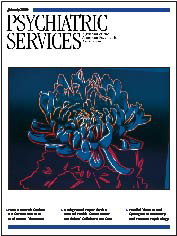To the Editor: In the Taking Issue commentary published in the December issue, Dr. Ragins describes being surprised that in the National Institute of Mental Health's CATIE study first- and second-generation antipsychotics were not found to be substantially different in effectiveness; he also notes that he was "amazed to read how poorly all the patients had fared." He sees the study as a "wake-up call" and asks a series of questions about the clinical environment in which the study was carried out—questions about the doctor-patient relationship and how medications are integrated with other therapies.
Having been the clinical director of the Illinois Mental Health Authority for the past ten years (I left my state position in September 2005), I share Dr. Ragin's concerns but not his surprise. If anything, I am afraid that the patients in the CATIE study fared better than average—definitely better than the typical patient in our public mental health system. For example, in community mental health centers (CMHCs) in Illinois, we have approximately one full-time-equivalent psychiatrist for every 1,100 patients; therefore, any discussion of doctor-patient relationships is moot. Because our Medicaid authority reimburses psychiatrists at approximately $20 per medication visit, our CMHCs find psychiatric care, at best, a loss leader.
Our own research on continuity highlights just how bad things really are. Using Medicaid pharmacy claims for a one-year period, we retrospectively examined data for all patients who were taking risperidone (which is paid for without need for prior approval by our Medicaid authority) at discharge from our state hospitals. Although at discharge patients were given a two-week supply of risperidone, during the next three weeks, more than half did not fill a prescription for an antipsychotic, and, of those who did, half received a medication other than risperidone. Over the course of two years, less than 1 percent continuously filled a prescription for risperidone (
1). In a subsequent study looking at continuity for both first- and second-generation antipsychotics, we found that 28 percent of those discharged on first-generation agents and 36 percent of those discharged on second-generation agents were never linked to a CMHC, and overall about two-thirds had dropped out before their third appointment (
2).
During the ten years of my tenure, Illinois' public mental health budget did not keep up with inflation. Despite the budget shortfalls, we excelled on the ORYX standards of the Joint Commission on Accreditation of Healthcare Organizations, prescribing second-generation antipsychotics rather than first-generation agents to more than 70 percent of our inpatients; second-generation antipsychotics now consume several hundred million dollars of our annual Medicaid authority's budget. The decision to reduce resources for other interventions while enormously expanding the medication budget was not necessarily one that would have been supported by consumers (
3), but it was a decision that we made. In hindsight it was a mistake.

